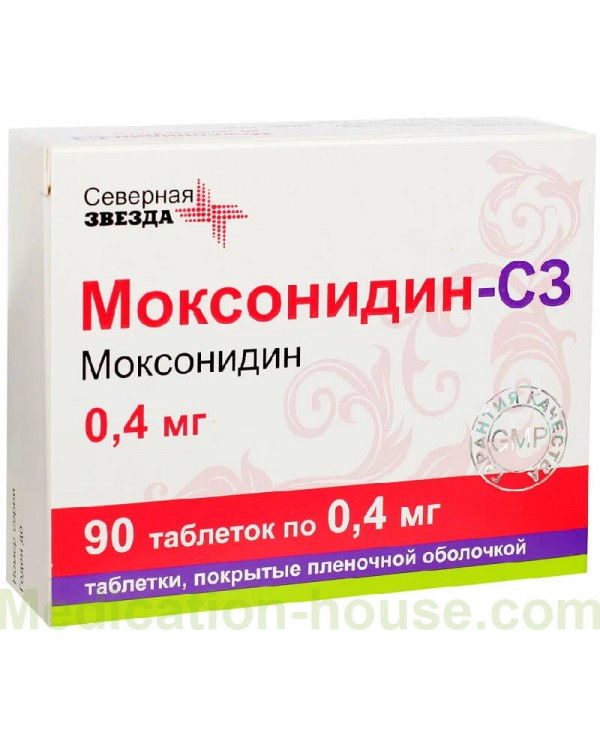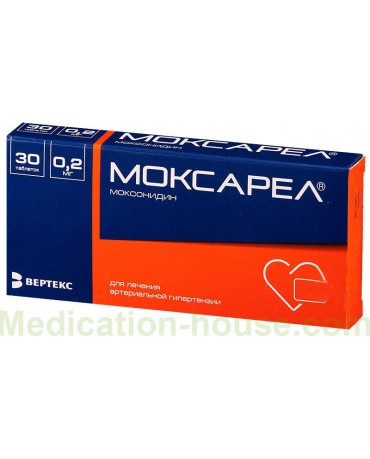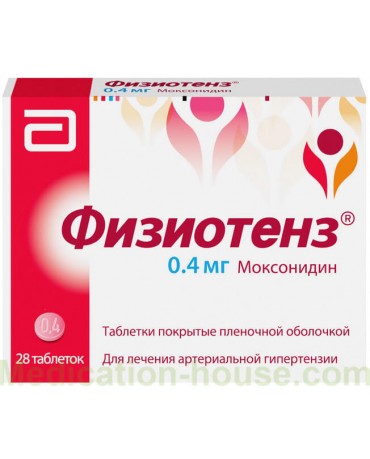Instruction for Moxonidine
Reed more and buy Moxonidine on this page
Moxonidine is a centrally acting antihypertensive drug.
Release form and composition
Film-coated tablets: round, biconvex, from pink to pale pink; 2 layers are visible in the cross section - a film shell and an almost white core (7, 10 and 14 pcs. in blisters, in a cardboard box 1, 2, 3, 4, 5, 6, 7, 8, 9 or 10 packages; 10, 20, 30, 40, 50, 60 and 100 pcs. in polyethylene terephthalate or polymer cans, in a cardboard box 1 can).
Composition of 1 tablet:
active substance: moxonidine - 0.2 or 0.4 mg;
excipients (core): magnesium stearate, croscarmellose sodium, povidone-K25, lactose monohydrate (milk sugar);
excipients (shell): titanium dioxide, macrogol-4000, hypromellose, iron dye red oxide.
Pharmacodynamics
Moxonidine - the active substance of the drug - a selective agonist of imidazoline receptors, which reduces sympathetic activity, selectively interacts with imidazoline I1 receptors, which are located in the brain stem.
The decrease in diastolic and systolic blood pressure with the use of moxonidine (single or long-term) is due to its ability to reduce the pressor effect of the sympathetic system on peripheral vessels and reduce peripheral vascular resistance, without significantly affecting cardiac output and heart rate.
The maximum antihypertensive effect is achieved 2.5-7 hours after oral administration of the drug.
Moxonidine has a high affinity for imidazoline I1 receptors. It binds to central alpha2-adrenergic receptors only slightly, which explains the sedative effect and dryness of the oral mucosa.
The drug stimulates the release of growth hormone, reduces tissue resistance to insulin.
Pharmacokinetics
Moxonidine absorption is 90%. The maximum plasma concentration after taking 0.2 mg of the drug is achieved in 30-180 minutes and is 1.4-3 ng / ml.
The bioavailability of the substance is 88%. Food intake does not affect its pharmacokinetics.
The volume of distribution is 1.8 ± 0.4 l / kg. It binds to blood plasma proteins by about 10%.
Penetrates the blood-brain barrier.
It is metabolized to form metabolites, mainly derivatives of guanidine and 4,5-dihydromoxonidine. The pharmacodynamic activity of the latter is about 10% compared to moxonidine.
The half-life (T1 / 2) of moxonidine is 2.5 hours, of metabolites - 5 hours.
The average final T1 / 2 of moxonidine in the blood plasma is 2.2-2.3 hours, the average final renal T1 / 2 is 2.6-2.8 hours.
Moxonidine is excreted mainly by the kidneys: within a day after administration - more than 90%, of which 50-75% - unchanged, 13% - in the form of a dehydrogenated derivative. In a small amount (no more than 1%) it is excreted through the intestines.
With prolonged use, moxonidine does not cumulate.
Changes in pharmacokinetic parameters are observed in patients of different ages, which is presumably associated with a higher bioavailability of the drug and / or decreased metabolic activity. However, these changes have no clinical significance.
Excretion of the drug is highly correlated with creatinine clearance (CC).
With moderate renal failure (CC 30-60 ml / minute), the equilibrium plasma concentrations and the final T1 / 2 are approximately 2 and 1.5 times higher, respectively, and with severe renal failure (CC <30 ml / minute) - 3 times, than in hypertensive patients with normal renal function (CC> 90 ml / minute).
With prolonged use, the drug does not accumulate in the body of patients with moderate renal failure.
In end-stage renal failure (CC <10 ml / min) in patients on hemodialysis, equilibrium plasma concentrations and final T1 / 2, respectively, are 6 and 4 times higher than in patients with normal night function.
Moxonidine is excreted in small quantities during hemodialysis.
Indications for use
The drug is used for arterial hypertension.
Contraindications
severe renal failure (CC less than 30 ml / min, plasma creatinine more than 160 μmol / l);
hemodynamically significant heart rhythm disturbances;
severe chronic heart failure III – IV functional class in accordance with the NYHA classification;
severe bradycardia (heart rate less than 50 beats / minute);
severe bradyarrhythmia, including sick sinus syndrome, atrioventricular block II and III degree;
lactase deficiency, lactose intolerance, glucose-galactose malabsorption;
age up to 18 years old and over 75 years old;
concomitant use of tricyclic antidepressants;
hypersensitivity to the components of the drug.
Due to the lack of experience in using the drug, it is not recommended to prescribe for the following diseases: Parkinson's disease, depression, glaucoma, epilepsy, Raynaud's disease, intermittent claudication.
The drug should be used with caution in the following cases:
a history of angioedema;
severe coronary heart disease;
bradycardia;
unstable angina;
severe coronary artery disease;
chronic heart failure I – II functional class according to NYHA classification;
atrioventricular block I degree;
chronic renal failure (CC 30-60 ml / min);
advanced age (from 60 to 75 years).
Instructions for use: method and dosage
Moxonidine is taken orally with a sufficient amount of liquid. Time of meals does not matter.
The starting dose is usually 0.2 mg in the morning. If the therapeutic effect after 3 weeks is not pronounced enough, you can increase the daily dose to 0.4 mg in 1 or 2 doses. If the therapeutic effect after 3 weeks is unsatisfactory, you can increase the daily dose to 0.6 mg in 2 divided doses - in the morning and in the evening.
The maximum allowable doses: single - 0.4 mg, daily - 0.6 mg.
Patients with renal insufficiency (CC 30-60 ml / minute) are prescribed 0.2 mg at the beginning of therapy. If the effect is not enough, you can increase the dose to 0.4 mg per day (only if the drug is well tolerated).
Side effects
from the digestive system: very often (≥ 1/10) - dryness of the oral mucosa; often (≥ 1/100 to <1/10) - diarrhea, nausea, vomiting, dyspepsia; infrequently (≥ 1/1000 to <1/100) - anorexia;
on the part of the organ of vision: infrequently - a burning sensation in the eyes, dry eyes;
on the part of the organ of hearing: infrequently - tinnitus;
on the part of the cardiovascular system: often - vasodilation; infrequently - impaired peripheral circulation, marked decrease in blood pressure (including orthostatic hypotension);
from the genitourinary system: infrequently - decreased libido and / or impotence;
from the endocrine system: infrequently - gynecomastia;
from the musculoskeletal system: often - back pain; infrequently - neck pain;
from the central nervous system: often - sleep disturbance, drowsiness, headache, vertigo, increased fatigue; infrequently - paresthesia, fainting;
mental disorders: often - impaired cognitive functions, insomnia; infrequently - anxiety, nervousness;
allergic reactions: often - itching, skin rash; infrequently - angioedema;
others: often - asthenia; infrequently - soreness in the parotid glands, weakness in the legs, peripheral edema.
Overdose
Symptoms: dryness of the oral mucosa, fatigue, drowsiness, headache, increased asthenia, sedation, dizziness, marked decrease in blood pressure, bradycardia; rarely - pain in the upper abdomen, vomiting. Also, presumably, hyperglycemia, tachycardia, paradoxical arterial hypertension are possible.
There is no specific antidote to the drug. Overdose treatment is aimed at eliminating the symptoms that have arisen. If a little time has passed since the moment of administration, it is recommended to rinse the stomach, take activated charcoal and a laxative to reduce the absorption of the drug. With bradycardia, the introduction of atropine is indicated, with a pronounced decrease in blood pressure - the restoration of the volume of circulating blood by the introduction of fluid and dopamine. Antagonists of α-adrenergic receptors help to eliminate or reduce paradoxical antihypertensive effects.
Special instructions
Blood pressure, heart rate and electrocardiogram should be monitored regularly during treatment.
Moxonidine should be canceled gradually, reducing the dose within 2 weeks.
With the concomitant use of beta-blockers, if it is necessary to cancel both drugs, beta-blockers should be canceled first, and after a few days - Moxonidine.
During the period of therapy, it is necessary to refrain from drinking alcohol.
Influence on the ability to drive vehicles and complex mechanisms
Due to the risk of drowsiness and dizziness when using the drug, it is recommended to refrain from performing potentially hazardous activities that require speed of reactions and increased attention, including driving.
Application during pregnancy and lactation
There is no experience of using the drug during pregnancy, so the drug can only be used in exceptional cases when the expected benefit outweighs the potential risks.
Moxonidine is excreted in breast milk, therefore, it is not prescribed during lactation, or breastfeeding should be stopped.
Childhood use
Pharmacokinetic studies on the use of the drug in patients under 18 years of age have not been carried out, therefore it is not used in pediatrics.
With impaired renal function
According to the instructions, the drug is contraindicated in severe renal failure (CC less than 30 ml / min, plasma creatinine more than 160 μmol / L).
For patients with impaired renal function, the dosage of the drug should be selected individually.
Use in the elderly
Moxonidine should be used with caution when treating elderly patients. Dosage recommendations are similar to those for adult patients with normal renal function. Treatment should be started with a minimum dose, the subsequent increase should be carried out under close medical supervision.
The drug is contraindicated in elderly people - over 75 years old.
Drug interactions
tricyclic antidepressants: a decrease in the hypotensive effect of moxonidine is possible;
antihypertensive drugs: the antihypertensive effect is mutually enhanced;
anxiolytics, barbiturates, ethanol: their depressing effect on the central nervous system is enhanced;
beta-blockers: increased bradycardia, negative dromo- and inotropic effects of moxonidine;
derivatives of benzodiazepine: it is possible to enhance their sedative effect;
tolazoline: the antihypertensive effect of moxonidine decreases (the degree of reduction depends on the dose of tolazoline);
lorazepam: Moderately enhanced cognitive decline in patients.
There is no pharmacokinetic interaction of moxonidine with hydrochlorothiazide, digoxin and glibenclamide.
Terms and conditions of storage
Shelf life is 3 years.
Storage conditions: inaccessible to children, protected from light place, temperature - up to 25 ° С.
Reviews
According to reviews, Moxonidine is an effective antihypertensive agent that reduces high blood pressure both with a single dose and with prolonged use.
Terms of sell
A prescription is not required to buy Moxonidine.



